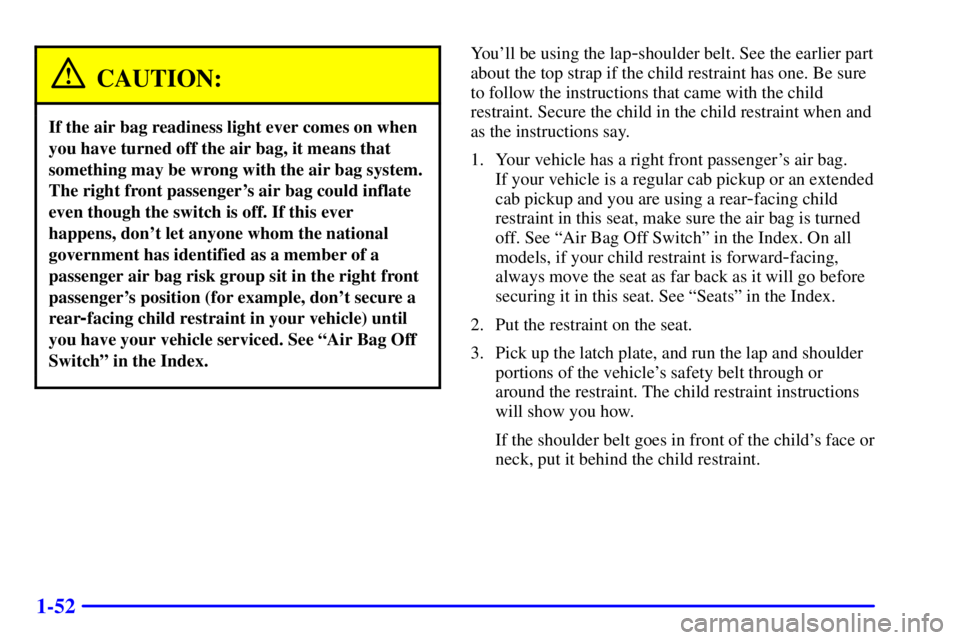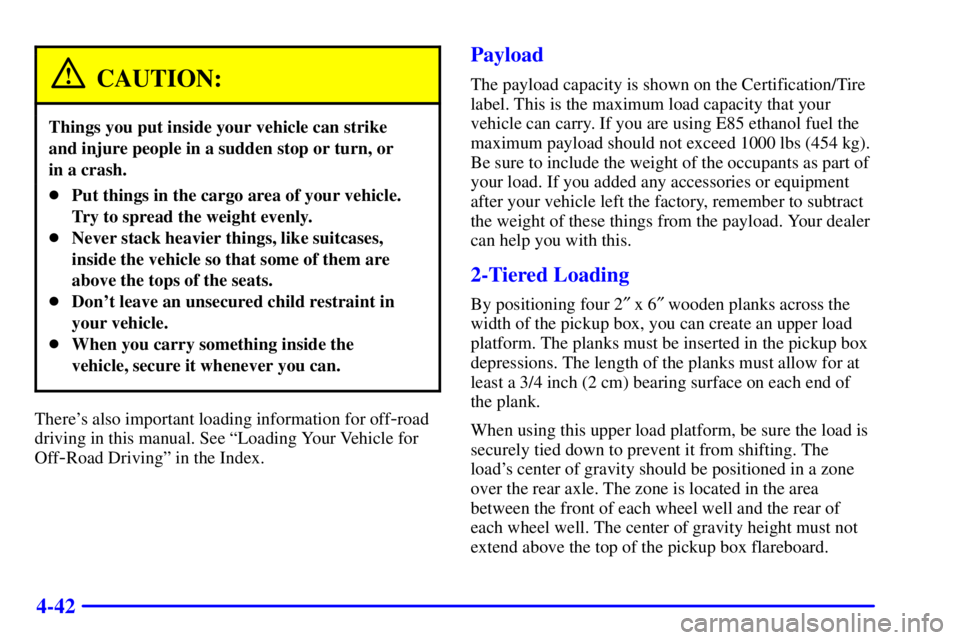Page 64 of 407
1-51
Unless your vehicle has the air bag off switch and the
passenger's air bag has been turned off, never put a
rear
-facing child restraint in the right front passenger's
seat. Here's why:
CAUTION:
A child in a rear-facing child restraint can be
seriously injured or killed if the right front
passenger's air bag inflates. This is because the
back of the rear
-facing child restraint would be
very close to the inflating air bag. If your vehicle
is a crew cab, do not use a rear
-facing child
restraint in the right front passenger's position.
If your vehicle is a regular cab pickup or an
extended cab pickup, be sure to turn off the air
bag before using a rear
-facing child restraint in
the right front seat position.
If a forward-facing child restraint is suitable for
your child, always move the passenger seat as far
back as it will go.
Although a rear seat is a safer place, you can secure a
forward
-facing child restraint in the right front seat of a
crew cab.
Page 65 of 407

1-52
CAUTION:
If the air bag readiness light ever comes on when
you have turned off the air bag, it means that
something may be wrong with the air bag system.
The right front passenger's air bag could inflate
even though the switch is off. If this ever
happens, don't let anyone whom the national
government has identified as a member of a
passenger air bag risk group sit in the right front
passenger's position (for example, don't secure a
rear
-facing child restraint in your vehicle) until
you have your vehicle serviced. See ªAir Bag Off
Switchº in the Index.
You'll be using the lap-shoulder belt. See the earlier part
about the top strap if the child restraint has one. Be sure
to follow the instructions that came with the child
restraint. Secure the child in the child restraint when and
as the instructions say.
1. Your vehicle has a right front passenger's air bag.
If your vehicle is a regular cab pickup or an extended
cab pickup and you are using a rear
-facing child
restraint in this seat, make sure the air bag is turned
off. See ªAir Bag Off Switchº in the Index. On all
models, if your child restraint is forward
-facing,
always move the seat as far back as it will go before
securing it in this seat. See ªSeatsº in the Index.
2. Put the restraint on the seat.
3. Pick up the latch plate, and run the lap and shoulder
portions of the vehicle's safety belt through or
around the restraint. The child restraint instructions
will show you how.
If the shoulder belt goes in front of the child's face or
neck, put it behind the child restraint.
Page 68 of 407
1-55
Older Children
Older children who have outgrown booster seats should
wear the vehicle's safety belts.
If you have the choice, a child should sit next to a
window so the child can wear a lap
-shoulder belt and
get the additional restraint a shoulder belt can provide.
Q:What is the proper way to wear safety belts?
A:If possible, an older child should wear a
lap
-shoulder belt and get the additional restraint a
shoulder belt can provide. The shoulder belt should
not cross the face or neck. The lap belt should fit
snugly below the hips, just touching the top of the
thighs. It should never be worn over the abdomen,
which could cause severe or even fatal internal
injuries in a crash.
In a crash, children who are not buckled up can strike
other people who are buckled up, or can be thrown
out of the vehicle. Older children need to use safety
belts properly.
Page 69 of 407
1-56
CAUTION:
Never do this.
Here two children are wearing the same belt. The
belt can't properly spread the impact forces. In a
crash, the two children can be crushed together
and seriously injured. A belt must be used by
only one person at a time.
Q:What if a child is wearing a lap-shoulder belt,
but the child is so small that the shoulder belt is
very close to the child's face or neck?
A:Move the child toward the center of the vehicle, but
be sure that the shoulder belt still is on the child's
shoulder, so that in a crash the child's upper body
would have the restraint that belts provide. If the
child is so small that the shoulder belt is still very
close to the child's face or neck, you might want to
place the child in a seat that has a lap belt, if your
vehicle has one.
Page 70 of 407
1-57
CAUTION:
Never do this.
Here a child is sitting in a seat that has a
lap
-shoulder belt, but the shoulder part is behind
the child. If the child wears the belt in this way, in
a crash the child might slide under the belt. The
belt's force would then be applied right on the
child's abdomen. That could cause serious or
fatal injuries.
Wherever the child sits, the lap portion of the belt
should be worn low and snug on the hips, just touching
the child's thighs. This applies belt force to the child's
pelvic bones in a crash.
Page 220 of 407

4-42
CAUTION:
Things you put inside your vehicle can strike
and injure people in a sudden stop or turn, or
in a crash.
�Put things in the cargo area of your vehicle.
Try to spread the weight evenly.
�Never stack heavier things, like suitcases,
inside the vehicle so that some of them are
above the tops of the seats.
�Don't leave an unsecured child restraint in
your vehicle.
�When you carry something inside the
vehicle, secure it whenever you can.
There's also important loading information for off-road
driving in this manual. See ªLoading Your Vehicle for
Off
-Road Drivingº in the Index.
Payload
The payload capacity is shown on the Certification/Tire
label. This is the maximum load capacity that your
vehicle can carry. If you are using E85 ethanol fuel the
maximum payload should not exceed 1000 lbs (454 kg).
Be sure to include the weight of the occupants as part of
your load. If you added any accessories or equipment
after your vehicle left the factory, remember to subtract
the weight of these things from the payload. Your dealer
can help you with this.
2-Tiered Loading
By positioning four 2, x 6, wooden planks across the
width of the pickup box, you can create an upper load
platform. The planks must be inserted in the pickup box
depressions. The length of the planks must allow for at
least a 3/4 inch (2 cm) bearing surface on each end of
the plank.
When using this upper load platform, be sure the load is
securely tied down to prevent it from shifting. The
load's center of gravity should be positioned in a zone
over the rear axle. The zone is located in the area
between the front of each wheel well and the rear of
each wheel well. The center of gravity height must not
extend above the top of the pickup box flareboard.
Page:
< prev 1-8 9-16 17-24